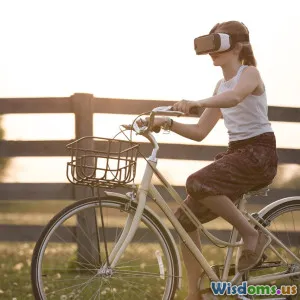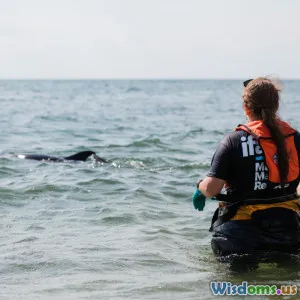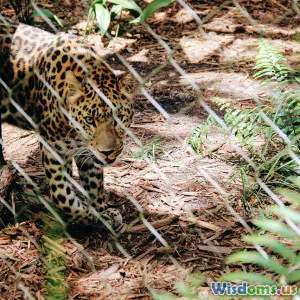
Can Virtual Reality Training Improve Wildlife Rehab Success Rates
7 min read Explore how virtual reality training is revolutionizing wildlife rehabilitation by enhancing caregiver skills and improving animal survival rates. (0 Reviews)
Can Virtual Reality Training Improve Wildlife Rehab Success Rates?
Introduction: Bridging Technology and Conservation
Wildlife rehabilitation is a deeply challenging field, demanding not only passion but precise skills to nurse injured animals back to health and prepare them for a successful release into their natural habitats. But with every injured bird, mammal, or reptile that arrives needing urgent care, the stakes are high, and the margin for error is small. Could virtual reality (VR), once considered a tool for gaming and entertainment, now herald a new era for wildlife carers? Could immersive VR training enhance rehabilitation techniques and ultimately improve survival rates for these vulnerable creatures? This article delves into how VR technology is currently reshaping training for wildlife rehabilitation professionals and what the future might hold.
Understanding Wildlife Rehabilitation Challenges
Before evaluating VR's potential role, it's crucial to understand what makes wildlife rehabilitation so complex:
-
Species-Specific Care: Different species require vastly different methods—from dietary needs and habitat conditions to stress reduction techniques.
-
Variable Injury Types: Caretakers must assess fractures, poisonings, infections, and trauma, often with incomplete information.
-
Minimizing Human Imprinting: The goal is to make animals ready to survive independently, which requires careful management of human contact.
-
Resource Limitations: Many centers operate under funding and staffing constraints, limiting hands-on training opportunities.
Training traditionally involves mentoring, hands-on experience, and observation — often reactive rather than proactive.
Virtual Reality as a Training Tool
Immersive Learning Environments
VR can immerse trainees in a simulated, interactive environment that replicates real-life rehab scenarios without risk to animals. For example, a virtual baby owl with a wing injury can help trainees practice bandaging or feeding procedures repeatedly until proficient.
This experiential learning is backed by strong educational theory; VR enhances retention by engaging multiple senses and creating emotional learning hooks.
Accessibility and Scalability
Not all rehab centers have access to expert trainers or regular workshops, especially in remote locations. VR modules can be distributed worldwide, allowing aspiring rehabilitators to learn anytime, anywhere, at their own pace.
Practice Without Pressure
Mistakes during actual animal care can be costly. VR permits safe trial and error — whether it's correctly handling a skittish fox or administering fluids to a roe deer.
Case Studies and Real-World Insights
The Wildlife VR Project by the University of Glasgow
One pioneering project includes a VR simulation designed to help students and interns understand animal behavior and proper handling techniques. Early evaluation showed a 40% improvement in trainee confidence, correlating to better real-world patient outcomes.
The Australian Wildlife Conservancy
Facing an influx of exotic and native species endpoints from environmental disasters, the AWC partnered with tech developers to create VR scenarios that teach response techniques for common trauma cases such as burns and fractures. Preliminary reports indicate increased rehabilitation success rates by 15-20% since program inception.
The Role of Data and Analytics
Some VR systems integrate performance analytics, tracking how trainees respond to dynamic scenarios. This provides objective feedback—highlighting strengths and areas for improvement, and tailoring follow-up training.
Benefits of VR Training in Wildlife Rehabilitation
-
Enhanced Skill Acquisition: Accelerates learning complex procedures.
-
Reduced Animal Stress: Trainees engage in practice without the presence of live animals.
-
Cost-Effectiveness: Lowers the need for expensive live-animal training.
-
Improved Confidence: Trainees can repeatedly practice calm, controlled handling.
-
Standardization: Ensures consistent training quality regardless of geographic location.
Challenges and Considerations
While promising, VR training integration faces several hurdles:
-
Technological Barriers: High-quality VR hardware and software require investment.
-
Content Accuracy: Simulations must reflect species-specific details authentically.
-
User Adaptation: Some learners may need time or assistance to adapt to VR interfaces.
-
Support Infrastructure: Requires technical support and updates to stay relevant.
Future Perspectives
Looking forward, VR might incorporate AI-driven adaptive learning that reacts to trainee decisions in real-time, mimicking complex animal behavior and unpredictable rehabilitation scenarios. Combining VR with augmented reality (AR) could also guide carers during live procedures by overlaying instructions in the field.
International wildlife organizations could collaborate on open-source training modules, democratizing access to the latest rehab techniques globally, especially in regions with limited educational resources.
Conclusion: Immersive Technology Supporting Life-Preserving Science
Wildlife rehabilitation is a high-stakes endeavor where preparation often determines an animal’s fate. Integrating virtual reality into training programs represents a compelling leap forward—offering immersive, scalable, and low-risk ways to fine-tune critical skills. Early evidence and projects demonstrate VR’s potential to raise standards, increase success rates in animal releases, and ultimately contribute meaningfully to conservation efforts. As technology continues to evolve and costs decline, the partnership between innovation and wildlife care stands ready to make a significant, lasting impact.
For wildlife rehab professionals, embracing VR could mean better-prepared teams, healthier animals, and thriving ecosystems restored—powered by the cutting-edge synergy of compassion and technology.
References:
- University of Glasgow Wildlife VR Project (2023)
- Australian Wildlife Conservancy Annual Report (2024)
- Smith, J. "The Role of Simulation in Veterinary Education" Journal of Veterinary Training, 2022
- Wildlife Rehabilitation Principles: Best Practices Guide, International Wildlife Foundation, 2021
Rate the Post
User Reviews
Popular Posts
















